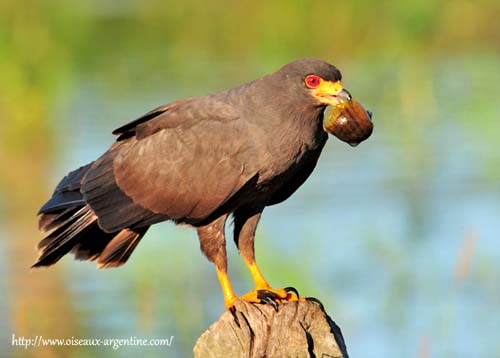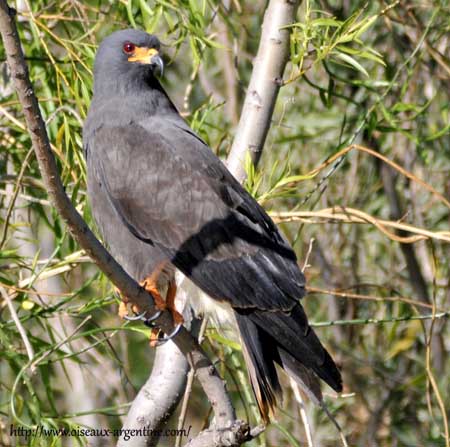
Snail Kite
Rostrhamus sociabilis
Accipitriforme Order – Accipitridae Family
BIOMETRICS:
Length: 45 cm ; Wingspan: 120 cm ; Weight: 360-520 g
LONGEVITY: up to 17 years
DESCRIPTION:
Snail Kite is medium-sized. It has broad wings and relatively long tail. Bill is different from other kites species, more slender and sharply curved.
Adult male has blackish-slate plumage almost overall. Flight feathers and rectrices are darker, nearly black, whereas upper wing coverts show faint brownish-grey wash. On the tail, upper and under tail coverts are whitish, as base of the tail. Rectrices are tipped whitish, and we can see a broad blackish subterminal band. Tail is squared, slightly forked.
Head is blackish-slate. Slender bill is black with strongly hooked upper mandible. In breeding season, cere, gape and mouth’s corners are red. In non breeding plumage, they are orange. Eyes are red, with red eye-ring and lores (yellow in non breeding period). Legs and feet are orange-yellow, with black, long, curved claws.
Adult female has dusky plumage, turning black on nape, crown, head and neck sides. We can see an indistinct buff line above the eye.
On the underparts, throat and breast are dusky streaked with buff. Under wing coverts are densely spotted with dusky and russet, and flight feathers are barred with pale reddish to whitish and fuscous. Tail is as in male.
She has orange eyes and yellow lores, cere, legs and feet (orange in breeding season). Female is slightly larger than male.
Juvenile is similar to female, but darker above and heavily marked below. Eyes are brownish. Bare facial skin, legs and feet are yellowish.
Immature resembles female but it has streaked crown.
Subadult acquires definitive plumage at about 3 to 4 years of age.
Three years old males are more greyish than adult females.
HABITAT:
Snail Kite lives in freshwater marshes, where it can find perches, bushes for roosting, and nest-sites in low shrubs and trees.
RANGE:
Snail Kite is found in southern Florida, and from eastern Mexico, southwards to Central and South America, to Uruguay and Argentina. We can find local populations in Cuba and on the Isle of Pines.
In Central Argentina where winters can be hard, Snail Kite migrates further north.
BEHAVIOUR:
Snail Kite is a specialized forager, only feeding on large freshwater snails. It hovers or flies slowly above water, and extends its talons towards water, in order to grasp snails placed on stems in marsh vegetation. Then, kite flies to a perch, holding the snail in one foot. It has to remove the operculum covering the entrance of the shell, and then, it tears it off and discards it. The bird inserts its appropriate bill into the aperture, cuts the muscle linking the body to the shell, and extracts it and usually swallows it whole.
Snail Kite forages in groups, in close proximity. But sometimes, some of them defend small feeding areas. This kind of snail is captured in water as deep as 15 cm.
Snail Kites are very gregarious and roost together in leafless bushes. They gather in each bush at dusk. During the day, groups of up to 15 to 20 birds can rest or preen, perched on bare branches in trees. They often nest in small colonies.
Snail Kite is nomadic, but not migratory. It can disperse from areas, according to weather conditions, and move in search of other suitable habitats.
During breeding season, Snail Kite performs conspicuous displays. Male performs undulating flight displays to females, series of short, swooping dives with closed wings over some metres before to rise again. It also carries sticks in the bill.
Male and female can also soar together, while doing dives, turns and rolls. They perform “grappling” flight, birds flying while they turn sideway with outstretched feet, uttering bleating cries. Sometimes, male may present prey to female which swallows it, and then copulation occurs at nest.
Mates utter different sounds at nest, such as gurgling or rattling calls.
FLIGHT:
Snail Kite performs acrobatic flight displays during breeding season. However, it also flies slowly over water searching for snails. It sometimes circles higher, soaring on fixed wings in thermals.
REPRODUCTION:
Breeding season is in relation to rainfalls and water levels, and occurs from February to July, but this species can breed in all months in the year.
Snail Kite usually breeds in loose colonies. Nest is often located in low tree or shrub, at about 2 to 3 metres above water, sometimes higher.
It is a bulky platform built in emergent vegetation. Structure is often loosely built, and can be destroyed and eggs lost. Both adults build the nest with dry sticks and other dry vegetation. Interior is lined with finer dry materials such as leaves and grasses, or vines.
PROTECTION / THREATS / STATUS:
Snail Kite is in decline in some parts of its range, due to habitat loss. Degradation of breeding and wintering habitats in Florida is an important threat, with drainage of numerous wetlands. Water quality is also reduced. Human activities such as fishing and boating disturb the birds at nest. Pesticides and other toxics are other kinds of threat.
This species is highly protected by laws. It is widespread and common in South America, but listed as Endangered Species in the United States, because its small populations and extremely specialized habitat.
Fr: Milan des marais
All : Schneckenweih
Esp : Caracolero Común
Ital : Nibbio delle Everglades
Nd : Slakkewouw
Russe : Общественный коршун-слизнеед
Sd : Snäckglada
Photographers:
Tom Grey
Tom Grey's Bird Pictures
Philippe et Aline Wolfer
OISEAUX D'ARGENTINE
Text by Nicole Bouglouan
Sources:
HANDBOOK OF THE BIRDS OF THE WORLD Vol 2 by Josep del Hoyo-Andrew Elliot-Jordi Sargatal - Lynx Edicions - ISBN: 8487334156
A GUIDE TO THE BIRDS OF COLOMBIA by Steven L. Hilty and William L. Brown
Princeton University Press – ISBN 069108372X
Wikipedia (Wikipedia, The Free Encyclopedia)
All About Birds (Cornell Lab of Ornithology)
Audubon
What Bird-The ultimate Bird Guide (Mitchell Waite)
The Hawk Conservancy Trust (Hilary Smith)
Arthur Grosset's Birds (Arthur Grosset)
Animal Diversity Web (University of Michigan Museum of Zoology)
El Zoológico Electrónico (Damisela)
SORA Searchable Ornithological Research Archive (Blair O. Wolf)

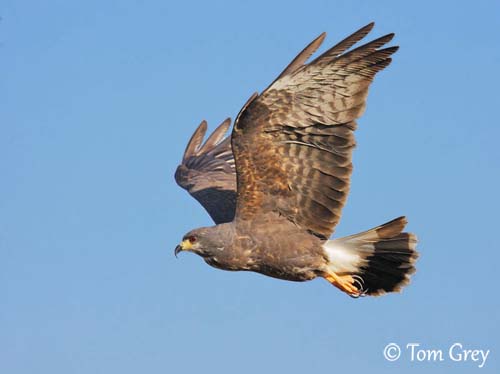
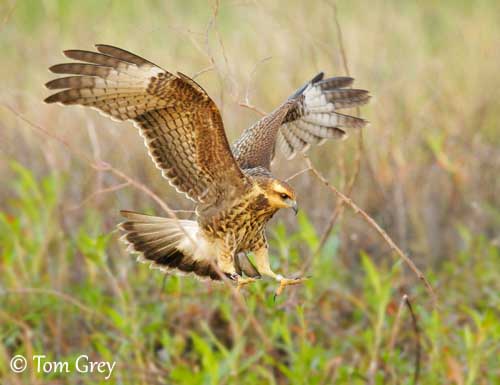
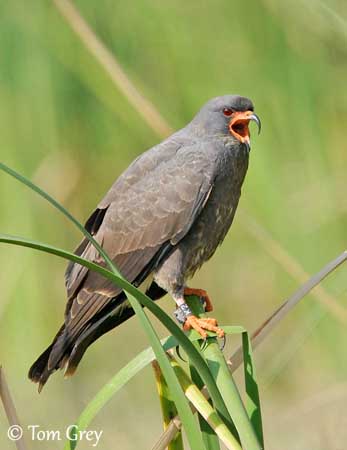
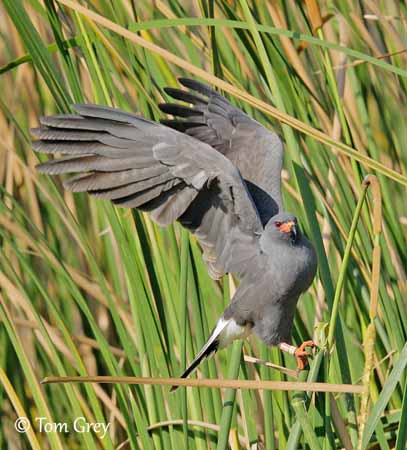
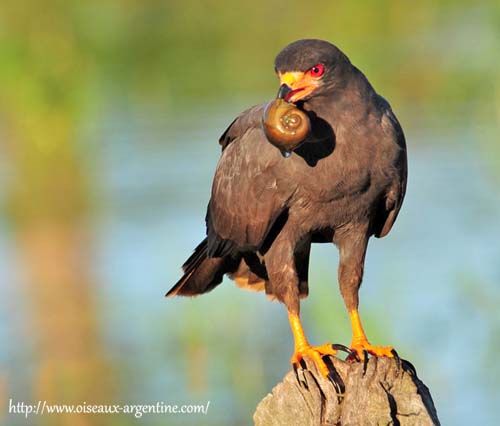
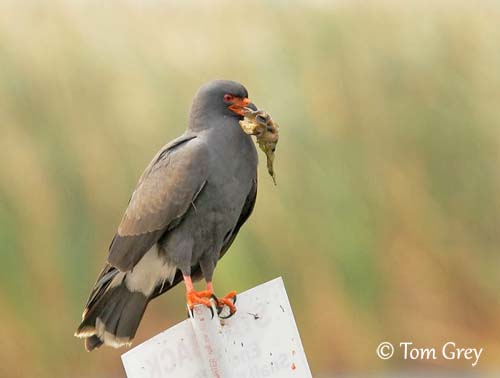
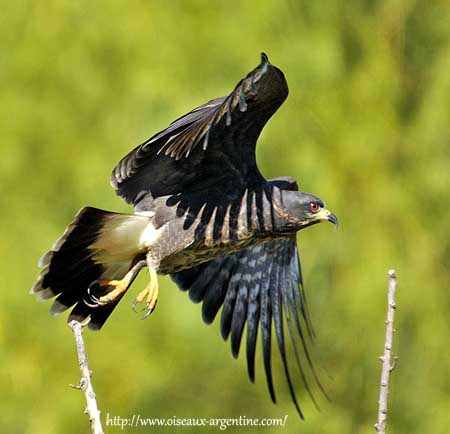
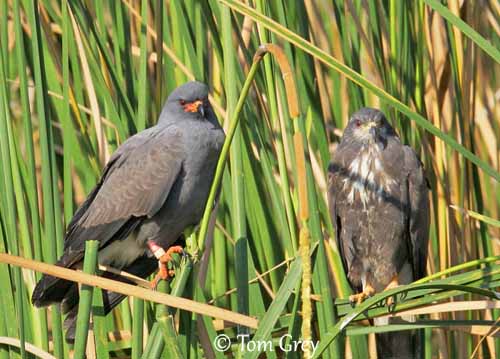
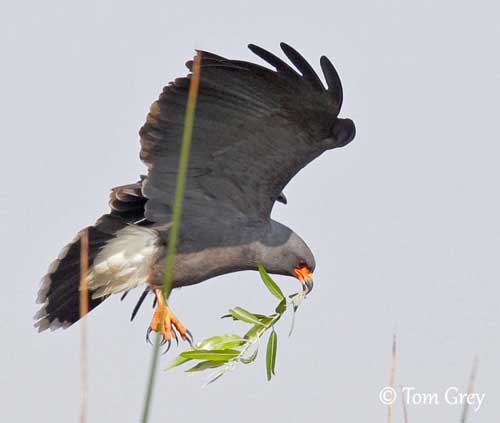
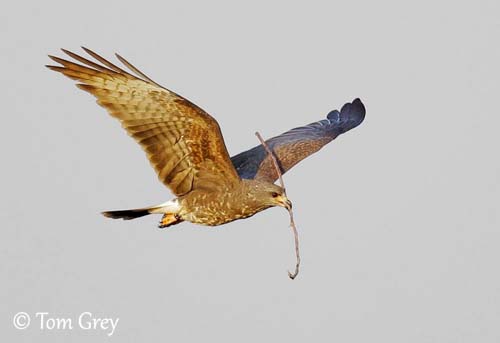
Female lays 2 to 3 dull white-cream eggs, with brown markings. Incubation lasts about one month, and both parents incubate and rear the young.
Young fledge about 26 to 28 days after hatching. They are not able to fly correctly, but only short distances. They are fed by adults for 9 to 11 weeks after hatching.
This species can produce 2 to 4 broods per year, usually two.
DIET:
Snail Kite feeds mainly on apple snails of genus Pomacea. It also takes regularly freshwater crabs in Venezuela, and Marisa snails in Colombia. It can eat small turtles with similar technique.
